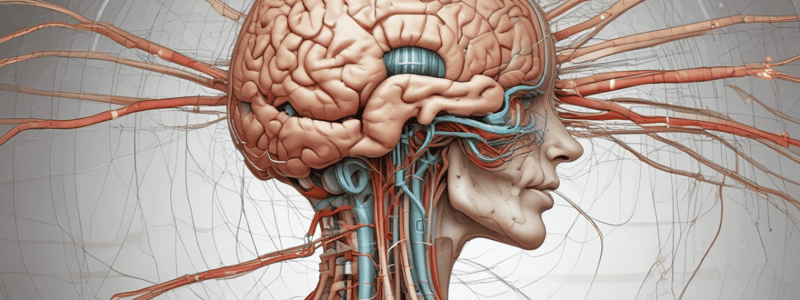Podcast
Questions and Answers
Where does the lateral corticospinal tract decussate?
Where does the lateral corticospinal tract decussate?
- Cervical cord
- Midbrain
- Thoracic cord
- Cervicoimedullary junction (correct)
Which tract facilitates flexor muscle tone and inhibits extensor muscle tone?
Which tract facilitates flexor muscle tone and inhibits extensor muscle tone?
- Anterior corticospinal tract
- Rubrospinal tract (correct)
- Vestibulospinal tracts
- Reticulospinal tract
What is the function of the vestibulospinal tracts?
What is the function of the vestibulospinal tracts?
- Facilitates extensor muscle tone
- Control bilateral axial and girdle muscles
- Automatic posture and gait related movements (correct)
- Positioning of head and neck
Which tract originates from the primary motor cortex and controls facial muscles?
Which tract originates from the primary motor cortex and controls facial muscles?
What is the main function of the reticulospinal tract?
What is the main function of the reticulospinal tract?
Where are the arms flexed and legs extended in the posturing known as decorticate posturing?
Where are the arms flexed and legs extended in the posturing known as decorticate posturing?
Flashcards are hidden until you start studying
Study Notes
Motor Tracts
- Lateral corticospinal tract (LCT) originates from primary motor and other frontal and partial areas, decussates at the cervicoimedullary junction, and terminates in the entire cord (mainly cervical and lumbosacral enlargement), controlling movement of contralateral limbs.
Characteristics of Motor Tracts
-
Anterior corticospinal tract (ACT) originates from primary motor cortex and SMA, terminates in cervical and upper thoracic cord, and controls bilateral axial and girdle muscles ipsilaterally.
-
Rubrospinal tract originates from red nucleus, decussates in the midbrain, terminates in cervical cord, and facilitates flexor muscle tone and inhibits extensor muscle tone in contralateral limbs.
-
Vestibulospinal tracts (VST) originate from medial and lateral vestibular nuclei, terminate in medial (cervical and upper thoracic cord) and lateral (entire cord) areas, and control positioning of head and neck (medial) and balance (lateral).
-
Reticulospinal tract originates from pontine and medullary reticular formation, terminates in entire cord, and regulates automatic posture and gait-related movements (reflexes and tone) ipsilaterally.
Corticobulbar Tract
- Corticobulbar tract originates from primary motor cortex, terminates in pons, and controls facial muscles with bilateral UMN innervation in the upper part of the face and contralateral UMN innervation in the lower part of the face.
Motor Lesions and Posturing
-
Decorticate posturing occurs with lesions above midbrain (cortex, corona radiata, internal capsule), involving rubrospinal and vestibulospinal tracts, and characterized by arms flexed and legs extended.
-
Decerebrate posturing occurs with lesions below or in the midbrain, involving vestibulospinal tract, and characterized by arms and legs extended.
Studying That Suits You
Use AI to generate personalized quizzes and flashcards to suit your learning preferences.




